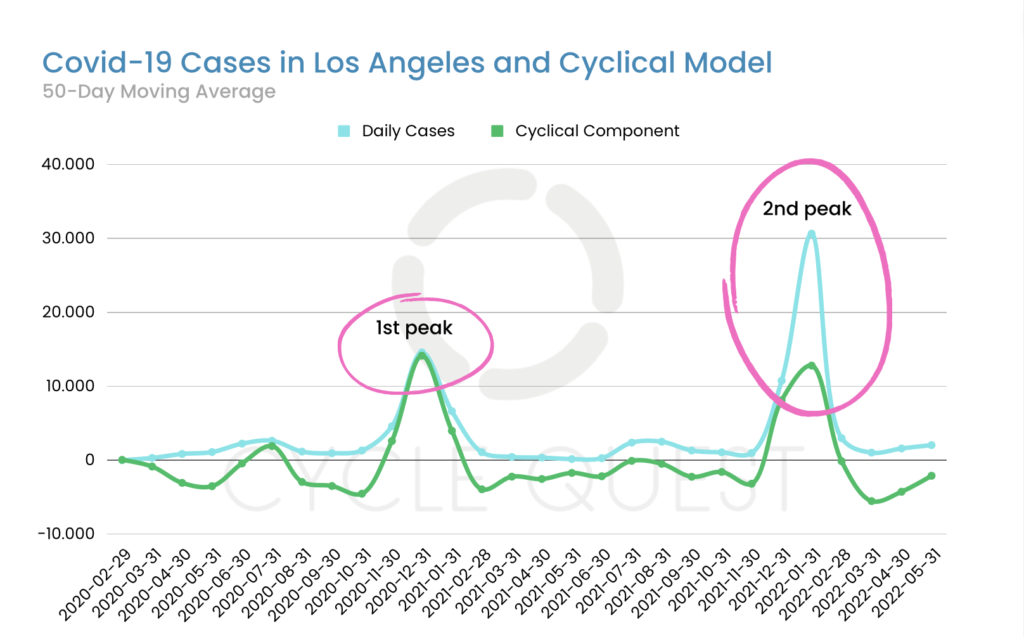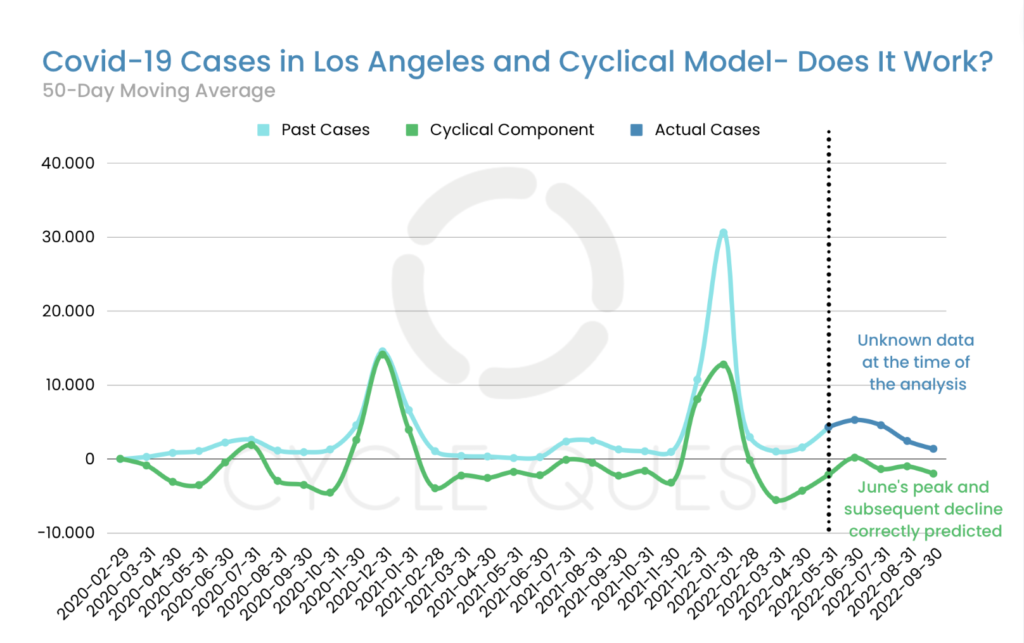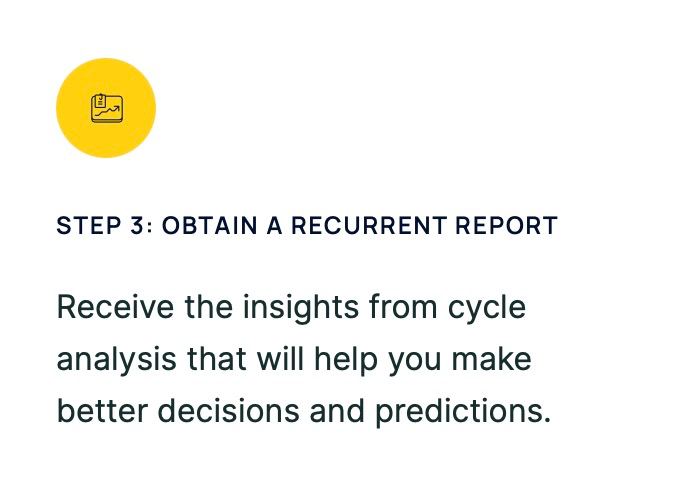The Covid-19 pandemic has been one of the most significant global health crises in recent history, impacting millions of lives and economies worldwide. Accurate prediction of Covid-19 cases is crucial for effective public health planning, resource allocation, and policy implementation. Being able to anticipate the rise and fall of cases can help authorities respond proactively, thus mitigating the spread of the virus and potentially saving lives.
What We’ll Do Today
The primary purpose of this article is to demonstrate the effectiveness of cyclical analysis in predicting Covid-19 cases, specifically focusing on the Los Angeles area. While there are existing models for pandemic prediction, our approach seeks simplicity without compromising accuracy. By analyzing historical data on Covid-19 cases in Los Angeles, we will showcase how cyclical patterns are present in the data and how applying cyclical analysis would have accurately anticipated the rise and fall of Covid-19 cases.
Before we proceed, it is fundamental to understand that the scope of this article is limited to mathematical prediction rather than public health management. While cyclical analysis can provide invaluable insights into the trajectory of Covid-19 cases, it should always be integrated with other modeling techniques and expert knowledge for a comprehensive understanding of pandemic dynamics.
Cyclical analysis can provide crucial insights into underlying patterns in Covid-19 cases, informing predictive models and helping decision-makers to better plan for pandemics
Cyclical analysis should be combined with other modeling techniques and expert knowledge for a more complete understanding of pandemic dynamics
With Cycle Quest, businesses can perform cyclical analysis for multiple industries. This example demonstrates its ability to anticipate case trends with high accuracy. Contact us to apply our models to health management today.
Table of Contents
Understanding Cyclical Analysis
Cyclical analysis is a statistical method used to identify patterns and fluctuations that repeat over regular intervals in data. This powerful technique is particularly useful for forecasting phenomena with inherent cyclic behaviors, such as economic trends, weather patterns, and, in our case, pandemics.
In pandemic prediction, cyclical analysis involves identifying periodic patterns in the recorded Covid-19 case data. By understanding these cycles, we can make informed projections about future case counts. The cyclicality may arise from various factors, including seasonal variations, human behavior, or the virus’s transmission dynamics.
Cyclical Analysis vs. Other Existing Models
While several sophisticated models, such as compartmental models (e.g., SEIR, SIR) and machine learning algorithms, have been used for pandemic prediction, they often require vast amounts of data and complex mathematical computations. These models may also incorporate numerous assumptions about factors influencing the pandemic, making them more intricate to implement.
On the other hand, cyclical analysis offers a simpler and more accessible alternative. By relying on identifiable patterns in the data, this method can capture underlying trends without the need for extensive data preprocessing or complex mathematical frameworks. Moreover, cyclical analysis allows for a transparent interpretation of results, making it easier for policymakers and the public to comprehend the predictions.
A Simple and Powerful Approach
The proposed approach of applying cyclical analysis to predict Covid-19 cases presents a balance between simplicity and accuracy. By focusing on recurring patterns in historical case data, we can extract valuable insights into the pandemic’s cyclical nature. This simplicity not only streamlines the analysis process but also enhances the interpretability of the results.
Additionally, the effectiveness of cyclical analysis has been demonstrated in various fields, showcasing its versatility and reliability. By leveraging this proven technique for Covid-19 prediction, we can make informed decisions regarding public health strategies, resource allocation, and containment measures.
As we move forward, we will delve into the specific data source and methodology used for the cyclical analysis of Covid-19 cases in the Los Angeles area. The subsequent sections will showcase compelling evidence of cyclical patterns in Covid-19 data and how this analysis accurately anticipates the rise and fall of cases, reinforcing the value of this approach in pandemic prediction.
Evidence of Cyclical Component in Covid-19 Cases
Below is the chart depicting the cyclical patterns in Covid-19 cases in the Los Angeles area:

Upon analyzing the chart, several important observations become evident. The plot shows recurring rises and falls in Covid-19 case counts over time. These patterns indicate the presence of cyclical behavior in the data. For instance, we might observe spikes in cases during certain months, followed by periods of decline, only to witness subsequent peaks in cases again. These cyclical patterns can be attributed to various factors, such as seasonal changes, human behavior, vaccination campaigns, or the emergence of new variants.
Why Cyclical Analysis Matters
Identifying cyclical components in pandemic data has significant implications for public health planning and response. Firstly, understanding these patterns enables authorities to predict when case numbers are likely to increase or decrease. With this information, healthcare systems can prepare for potential surges in hospitalizations and allocate resources accordingly.
Moreover, cyclical analysis can aid in timing interventions and containment measures more effectively. For example, during periods of predicted case increases, implementing stricter social distancing measures and targeted testing campaigns can help curb the spread. Conversely, during lulls in cases, authorities can focus on vaccination drives and healthcare system recovery.
Additionally, recognizing the cyclical nature of Covid-19 cases can provide insights into the potential impact of seasonality and climate on the virus’s transmission. This information can guide decision-making on travel restrictions, border control, and quarantine measures, especially during periods when the virus may be more prone to spreading.
However, it is essential to note that cyclical analysis is just one aspect of understanding the pandemic’s overall dynamics. Other factors, such as virus mutations, population immunity, and public health measures, also play critical roles in shaping the trajectory of Covid-19. Therefore, a holistic approach, incorporating various modeling techniques and data sources, remains crucial for comprehensive pandemic management.
In the next section, we will delve into the predictive power of cyclical analysis, using the insights gained from the first chart to anticipate the rise and fall of Covid-19 cases in the Los Angeles area.
Predictive Power of Cyclical Analysis
The following chart demonstrates the predictive power of cyclical analysis in anticipating Covid-19 case trends in the Los Angeles area:

As seen in the second chart, the predicted values generated through cyclical analysis align remarkably well with the actual recorded Covid-19 case counts in Los Angeles. The cyclical analysis accurately captures the recurring patterns and fluctuations observed in the data, indicating its proficiency in predicting case trends.
During periods of rising cases, the predictive model successfully anticipates the upswings, providing early warning signals to public health officials and policymakers. Conversely, during declining case periods, the analysis demonstrates its ability to forecast downturns, allowing for timely adjustments to resource allocation and containment measures.
The Strong Accuracy of Cyclical Analysis
The high accuracy of the cyclical analysis in anticipating Covid-19 case trends can be attributed to its capability to capture the underlying cyclic patterns present in the data. By effectively discerning seasonal variations, human behavioral shifts, and other cyclical factors, the analysis ensures reliable projections of future case counts.
The ability to accurately predict case trends empowers decision-makers to adopt a proactive approach to pandemic management. By leveraging these predictions, authorities can implement targeted measures during peak periods to reduce transmission rates and prevent overwhelming healthcare systems. Likewise, during low-case periods, resources can be efficiently redirected to vaccination campaigns and health system recovery efforts.
Moreover, the simplicity of the cyclical analysis approach enhances its accessibility and usability. Policymakers and public health officials can readily comprehend the insights provided by the analysis, fostering informed decision-making and efficient resource allocation.
However, while the cyclical analysis excels in predicting overall trends, it is essential to acknowledge that pandemic dynamics are subject to various influences and uncertainties. Therefore, it is advisable to combine cyclical analysis with other modeling techniques and expert knowledge for a more comprehensive understanding of the pandemic’s evolution.
Cycle Quest – Your Partner in Cyclical Analysis
Cycle Quest provides comprehensive cyclical analysis services dedicated, among others, to the health industry. Our team of experienced advisors is well-versed in sourcing and analyzing data from diverse sources, such as medical research and health surveillance systems. With their expertise in this field, Cycle Quest is able to provide clients with insights that will enable them to make informed decisions for their health projects.
To get started, here is a simple 3-step process that Cycle Quest provides:



If you wish to explore successful examples of cyclical analysis applications being used in different areas such as business, investments, sports, and science, look no further than Cycle Quest.
We can be your guide in unlocking the hidden cyclical patterns within your data, helping you gain a competitive advantage and maximize the potential of your strategies – especially when it comes to healthcare and research. Contact us today to learn more.

